Investigation of Local Tsunami Effect on Coastal Areas: A Case Study of Putian City, Fujian Province, China
Abstract
1. Introduction
2. Tsunami Source
3. Materials and Methods
3.1. High-Resolution Tsunami Inundation Model
3.2. Model Setup and Topographic Data
3.3. Numerical Model Validation
4. Numerical Results
4.1. Tsunami Wave Propagation Characteristics
4.2. Sensitivity of Seismic Parameters of Local Tsunami Source
4.3. Tsunami Inundation Modeling of Putian City
5. Discussion
- Detailed marine geophysical surveys are required to better understand the geometrical characteristic parameters of the fault. It is still impossible to accurately forecast the focal mechanism and parameters of each potential tsunami source, for example, the slip distribution of a seismic source. The rupture complexity may increase the uncertainty in the evaluation of the local tsunami hazard. For a local tsunami event, it was demonstrated in this study that for the scientific uniform rupture distribution of an identical tsunami source, a slight change in the rake or strike angle can change the tsunami wave amplitude by several tens of centimeters and the flooding area of the assessment area by tens of square kilometers. Thus, the precise rupture parameters are one of the highly required data for local tsunami risk assessment.
- The relative geographic positions, distance between the tsunami source and the site of interest are also important factors that determine the level of the local tsunami hazard and the tsunami travel time. Local tsunamis are more susceptible to the topography of the coastal environment. The coastal terrain of China is complicated, comprising estuary, bay, plain, and steep areas. Even within the same city, the local tsunami hazard mitigation measures at different coastal sites can be very different. Thus, it is necessary to conduct refined local tsunami hazard assessment and emergency response plans for high-risk cities in order to reduce disaster losses to the maximum extent possible.
- At the same time, a high-resolution grid model and coastal seawall-like structures data could help to get more accurate tsunami inundation calculations. In this study, the inundation simulation will be improved when higher resolution grid data is obtained. Tsunami inundation easily occurs into the low lands if there are no consecutive protections that are high enough along the coastlines. Many gaps in the seawall structures and the low coastal terrain are the reasons for the relatively serious inundation induced by local tsunamis in Putian City.
6. Conclusions
Author Contributions
Funding
Institutional Review Board Statement
Informed Consent Statement
Data Availability Statement
Acknowledgments
Conflicts of Interest
References
- Mak, S.; Chan, L.S. Historical tsunamis in South China. Nat. Hazards 2007, 43, 147–164. [Google Scholar] [CrossRef]
- Ren, Y.F.; Wen, R.Z.; Song, Y.Y. Recent progress of tsunami hazard mitigation in China. Episodes 2014, 37, 277–283. [Google Scholar]
- Kirby, S.; Geist, E. Great Earthquake Tsunami Sources: Empiricism and Beyond; USGS Tsunami Sources Workshop: Menlo Park, CA, USA, 2006. [Google Scholar]
- Yuan, Y.; Li, H.; Wei, Y.; Shi, F.; Wang, Z.; Hou, J.; Wang, P.; Xu, Z. Probabilistic Tsunami Hazard Assessment (PTHA) for Southeast Coast of Chinese Mainland and Taiwan Island. J. Geophys. Res. Solid Earth 2021, 126, e2020JB020344. [Google Scholar] [CrossRef]
- Liu, P.; Wang, X.M.; Salisbury, A.J. Tsunami hazard and early warning system in South China Sea. J. Asian Earth Sci. 2009, 36, 2–12. [Google Scholar] [CrossRef]
- Zhao, X.; Jiang, Y.P.; Ren, Z.Y.; Liu, H. Historical tsunami records and potential tsunami scenarios near Haikou coastal region. Nat. Hazards 2017, 89, 625–645. [Google Scholar]
- Qiu, Q.; Li, L.L.; Hsu, Y.J.; Wang, Y.; Chan, C.H.; Switzer, A.D. Revised earthquake sources along Manila trench for tsunami hazard assessment in the South China Sea. Nat. Hazards Earth Syst. Sci. 2019, 19, 1565–1583. [Google Scholar]
- Li, L.L.; Qiu, Q.; Li, Z.G.; Zhang, P.Z. Tsunami hazard assessment in the South China Sea: A review of recent progress and research gaps. Sci. China Earth Sci. 2022, 65, 783–809. [Google Scholar]
- Yang, Z.B. Probabilistic Tsunami Hazard Analysis Alone Chinese Coast. Master’s Thesis, China Earthquake Administration, Institute of Engineering Mechanics, Harbin, China, 2015. (In Chinese). [Google Scholar]
- Curtis, G.D.; Pelinovsky, E.N. Evaluation of tsunami risk for mitigation and warning. Sci. Tsunami Hazards 1999, 17, 187–192. [Google Scholar]
- Zhou, Q.; Adams, W.M. Tsunami risk analysis for China. Nat. Hazards 1988, 1, 181–195. [Google Scholar]
- Grezio, A.; Babeyko, A.; Baptista, M.A.; Behrens, J.; Costa, A.; Davies, G.; Geist, E.L.; Glimsdal, S.; González, F.I.; Griffin, J. Probabilistic tsunami hazard analysis: Multiple sources and global applications. Rev. Geophys. 2017, 55, 1158–1198. [Google Scholar] [CrossRef]
- Horspool, N.; Pranantyo, I.; Griffin, J. A probabilistic tsunami hazard assessment for Indonesia. Nat. Hazard Earth Sys. 2014, 14, 3105–3122. [Google Scholar] [CrossRef]
- Burbidge, D.; Cummins, P.R.; Mleczko, R.; Thio, H.K. A probabilistic tsunami hazard assessment for Western Australia. Pure Appl. Geophys. 2008, 165, 2059–2088. [Google Scholar] [CrossRef]
- Selva, J.; Lorito, S.; Volpe, M.; Romano, F.; Tonini, R.; Perfetti, P.; Bernardi, F.; Taroni, M.; Scala, A.; Babeyko, A.; et al. Probabilistic tsunami forecasting for early warning. Nat. Commun. 2021, 12, 1–14. [Google Scholar]
- Chock, G.Y.K.; Carden, L.; Robertson, I.; Wei, Y.; Wilson, R.; Hooper, J. Tsunami resilient building design considerations for coastal communities of Washington, Oregon, and California. J. Struct. Eng. 2018, 144, 04018116. [Google Scholar] [CrossRef]
- Li, H.W.; Wang, Z.C.; Yuan, Y.; Xu, Z.G.; Wang, P.T.; Shi, J.Y. Probabilistic tsunami hazard assessment in the Bohai Sea. Acta Oceanol. Sin. 2019, 41, 51–57. (In Chinese) [Google Scholar]
- Ren, Y.; Wen, R.; Zhang, P.; Yang, Z.; Pan, R.; Li, X. Implications of local sources to probabilistic tsunami hazard analysis in south Chinese coastal area. J. Earthq. Tsunami 2017, 11, 1740001. [Google Scholar] [CrossRef]
- Liu, Y. Regional Characteristics of the Probabilistic Tsunami Hazard for the Southeast Coastal Area of China. Master’s Thesis, China Earthquake Administration, Institute of Engineering Mechanics, Harbin, China, 2018. (In Chinese). [Google Scholar]
- Mueller, C.; Power, W.; Fraser, S.; Wang, X.M. Effects of rupture complexity on local tsunami inundation: Implications for probabilistic tsunami hazard assessment by example. J. Geophys. Res. Solid Earth 2015, 120, 488–502. [Google Scholar] [CrossRef]
- Goda, K.; Yasuda, T.; Mori, N.; Mai, P.M. Variability of tsunami inundation footprints considering stochastic scenarios based on a single rupture model: Application to the 2011 Tohoku earthquake. J. Geophys. Res. Oceans 2015, 120, 4552–4575. [Google Scholar] [CrossRef]
- Zhou, Q.; Adams, W.M. Tsunamigenic earthquakes in China: 1831 BC to 1980 AD. Sci. Tsunami Hazards 1986, 4, 131–148. [Google Scholar]
- Hou, J.; Li, X.; Yuan, Y.; Wang, P. Tsunami hazard assessment along the Chinese mainland coast from earthquakes in the Taiwan region. Nat. Hazard 2016, 81, 1269–1281. [Google Scholar]
- NOAA Tsunami Event Database. Available online: http://www.ngdc.noaa.gov/hazard/tsu_db.shtml (accessed on 21 May 2022).
- USGS Earthquake Archives. Available online: http://earthquake.usgs.gov/earthquakes/search/ (accessed on 11 May 2022).
- Xia, S.H.; Zhou, P.; Zhao, D.; Cao, J. Seismogenic structure in the source zone of the 1918 M7. 5 Nanao earthquake in the northern South China Sea. Phys. Earth Planet Inter. 2020, 302, 106472. [Google Scholar] [CrossRef]
- GB 18306-2015; Manual for National Seismic Ground Motion Parameters Zonation Map of China. Standards Press of China: Beijing, China, 2015.
- Papazachos, B.C.; Scordilis, E.M.; Panagiotopoulos, D.G.; Papazachos, C.B.; Karakaisis, G.F. Global relations between seismic fault parameters and moment magnitude of earthquakes. Bull. Geol. Soc. Greece 2004, 36, 1482–1489. [Google Scholar] [CrossRef]
- Liu, Z.L.; Ding, H.P. Discussion of magnitude and focal shock parameter based on numerical simulation of strong ground motion on the 1604 earthquake in the marine area near Quanzhou, Fujian. South China J. Seismol. 2011, 31, 1–10. (In Chinese) [Google Scholar]
- Okada, M. Surface deformation due to shear and tensile faults in a half-space. Bull Seism. Soc. Am. 1995, 75, 1135–1154. [Google Scholar]
- Cho, Y.S. Numerical Simulations of Tsunami and Runup. Ph.D. Thesis, Cornell University, Ithaca, NY, USA, 1995. [Google Scholar]
- Wang, X.M.; Liu, P. An analysis of 2004 Sumatra earthquake fault plane mechanisms and Indian Ocean tsunami. J. Hydraul. Eng. Res. 2006, 44, 147–154. [Google Scholar] [CrossRef]
- Wu, T.R.; Chen, P.F.; Tsai, W.T.; Chen, G.Y. Numerical study on tsunamis excited by 2006 Pingtung earthquake doublet. Terr. Atmos. Ocean. Sci. 2008, 19, 705–715. [Google Scholar]
- Hou, J.M.; Li, X.J.; Yuan, Y.; Ren, Z.Y.; Zhao, L.D.; Wang, Z.C.; Wang, J.C. Scenario-based tsunami evacuation analysis: A case study of Haimen town, Taizhou, China. J. Earthq. Tsunami 2017, 11, 1750008. [Google Scholar] [CrossRef]
- Heidarzadeh, M.; Muhari, A.; Wijanarto, A.B. Insights on the source of the 28 September 2018 Sulawesi tsunami, Indonesia based on spectral analyses and numerical simulations. Pure Appl. Geophys. 2019, 176, 25–43. [Google Scholar] [CrossRef]
- Rasyif, T.M.; Kato, S.; Syamsidik; Okabe, T. Numerical simulation of morphological changes due to the 2004 tsunami wave around banda aceh, indonesia. Geosciences 2019, 9, 125. [Google Scholar] [CrossRef]
- Tang, L.J.; Titov, V.V.; Wei, Y.; Mofjeld, H.O.; Spillane, M.; Arcas, D.; Newman, J. Tsunami forecast analysis for the May 2006 Tonga tsunami. J. Geophys. Res. Oceans 2008, 113, C12015. [Google Scholar] [CrossRef]
- Wei, Y.; Chamberlin, C.; Titov, V.V.; Tang, L.J.; Bernard, E.N. Modeling of the 2011 Japan Tsunami: Lessons for near-field forecast. Pure App. Geophys. 2012, 170, 1309–1331. [Google Scholar] [CrossRef]
- Shokin, Y.I.; Chubarov, L.B.; Novikov, V.A.; Sudakov, A.N. Calculations of tsunami travel times charts in the Pacific Ocean (models, algorithms, techniques, results). Sci. Tsunami Hazards 1987, 5, 85–113. [Google Scholar]
- Huang, Z.; Wang, S.X. Tectonic features and activity of Binhai fault zone in Taiwan Strait. J. Geod. Geodyn. 2006, 26, 16–26. (In Chinese) [Google Scholar]
- HY/T 0273.3-2021; Technical Directives for Risk Assessment and Zoning of Marine Disaster Part 3: Tsunami. Standards Press of China: Beijing, China, 2021.

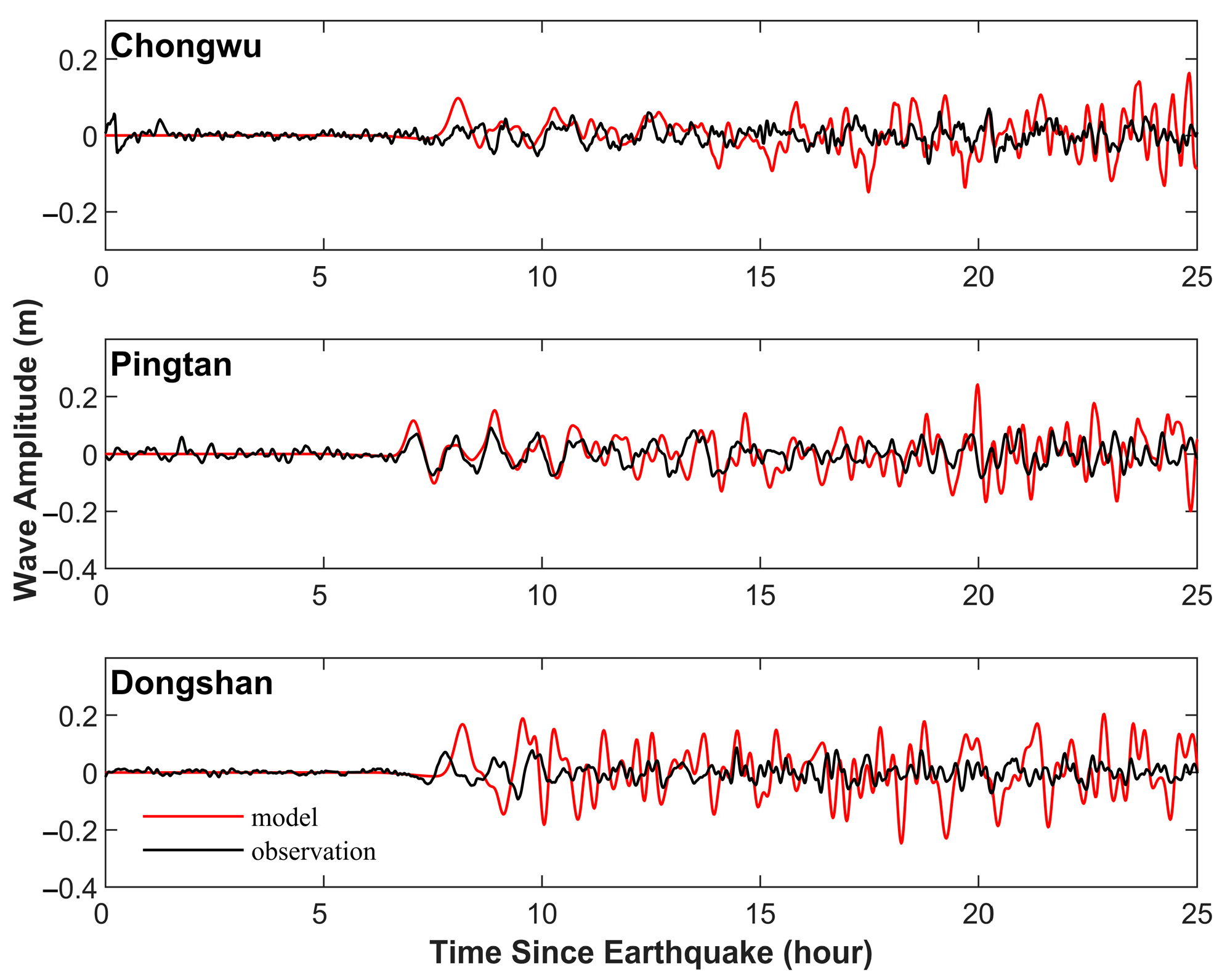
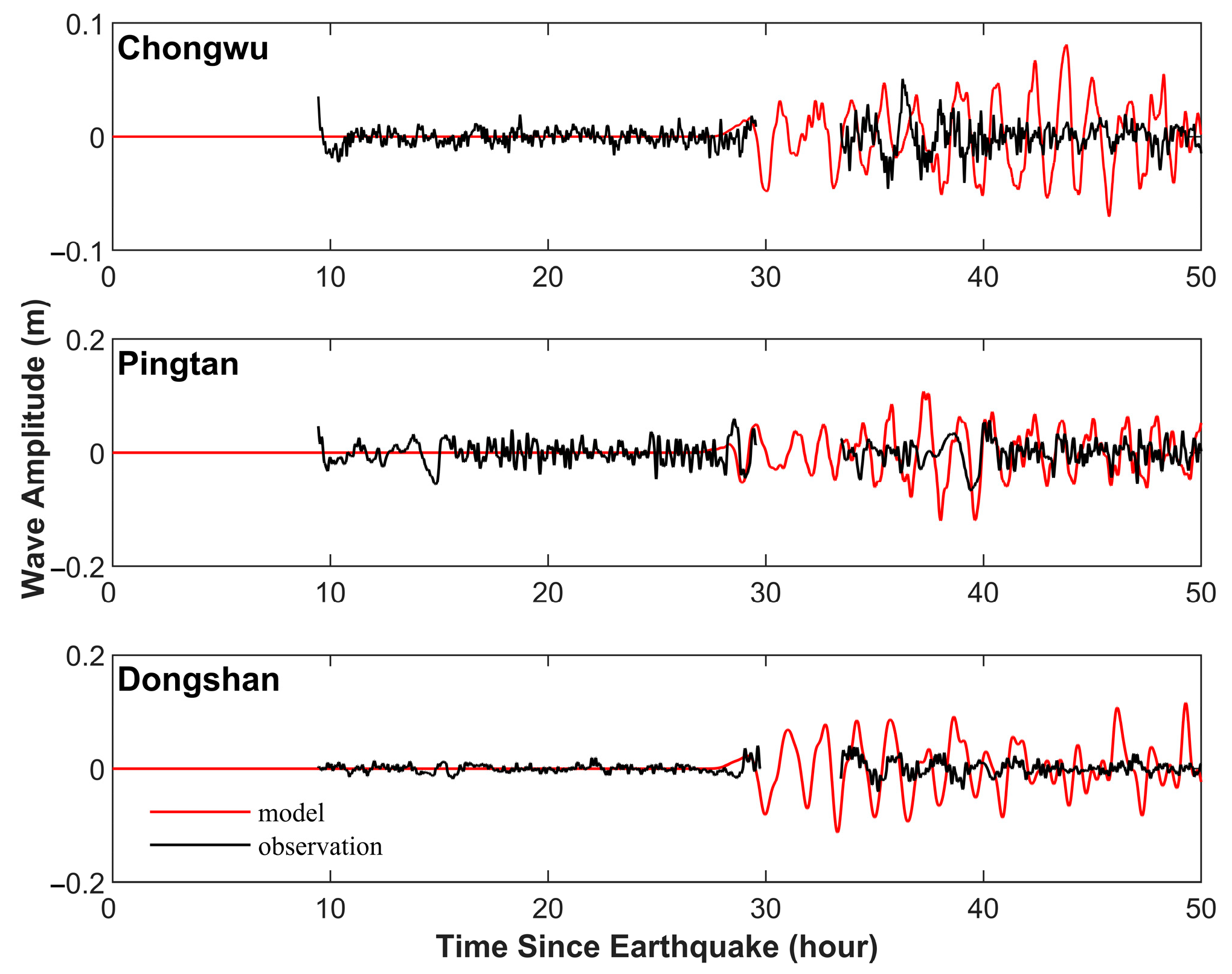
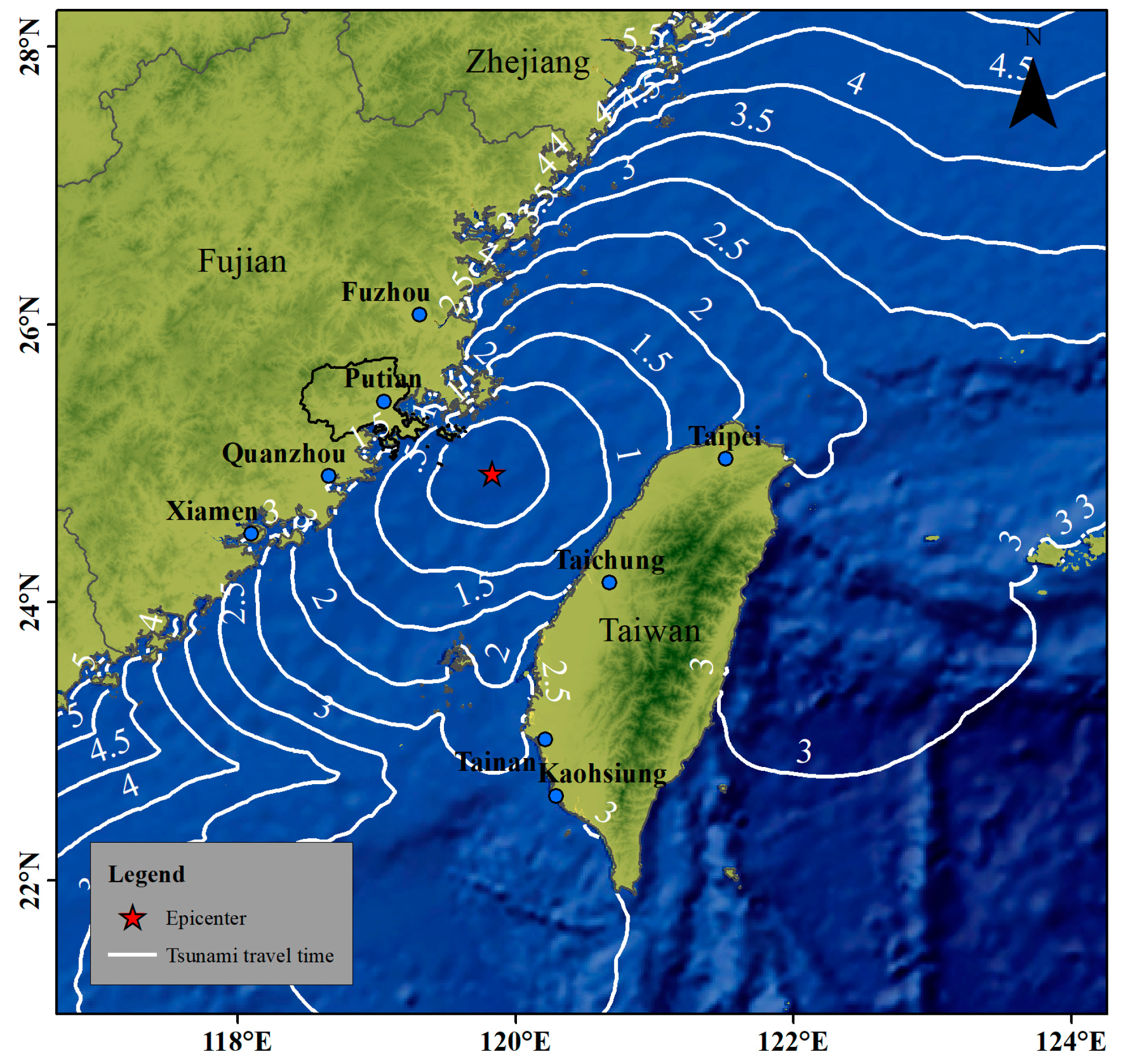
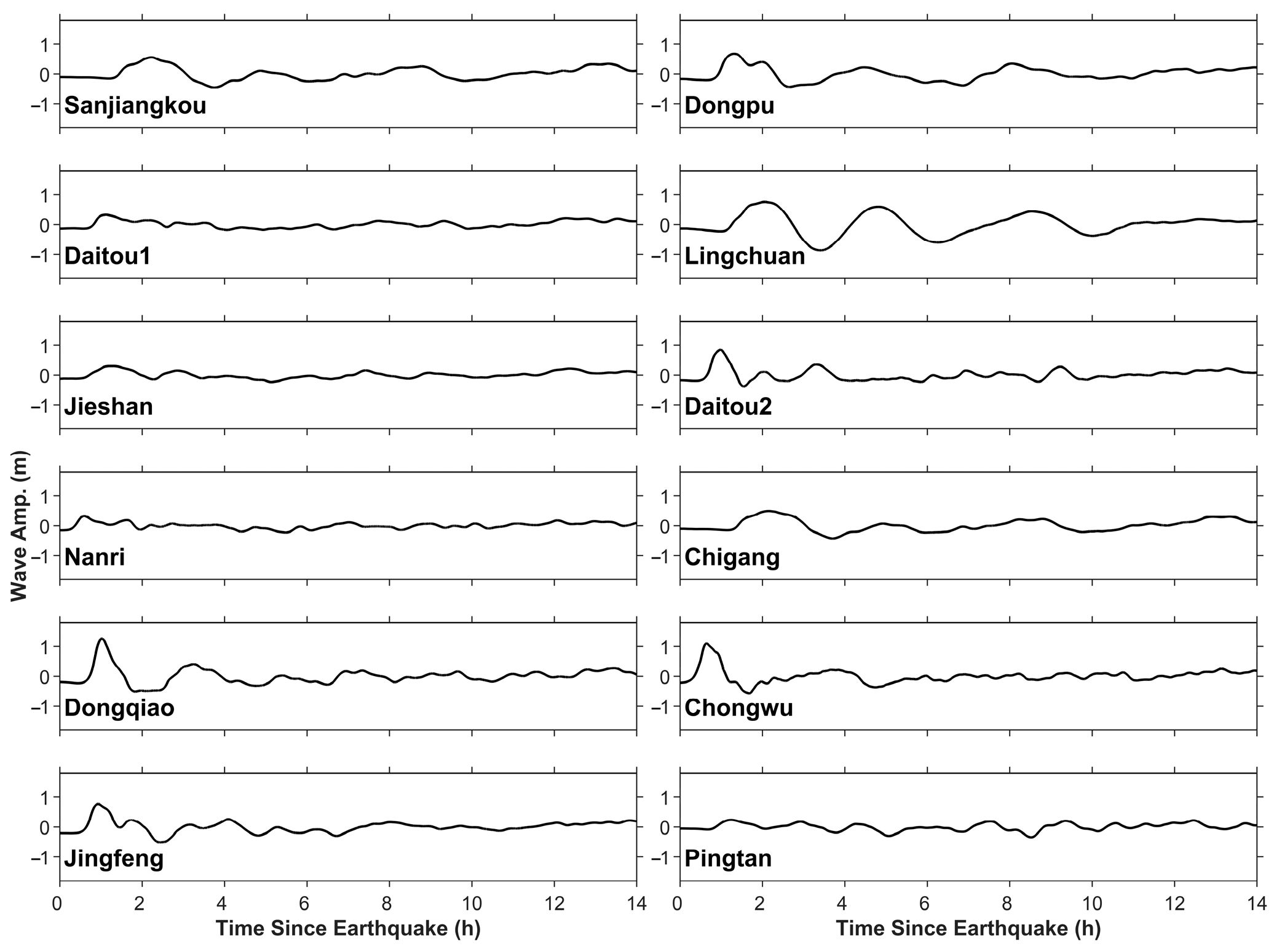



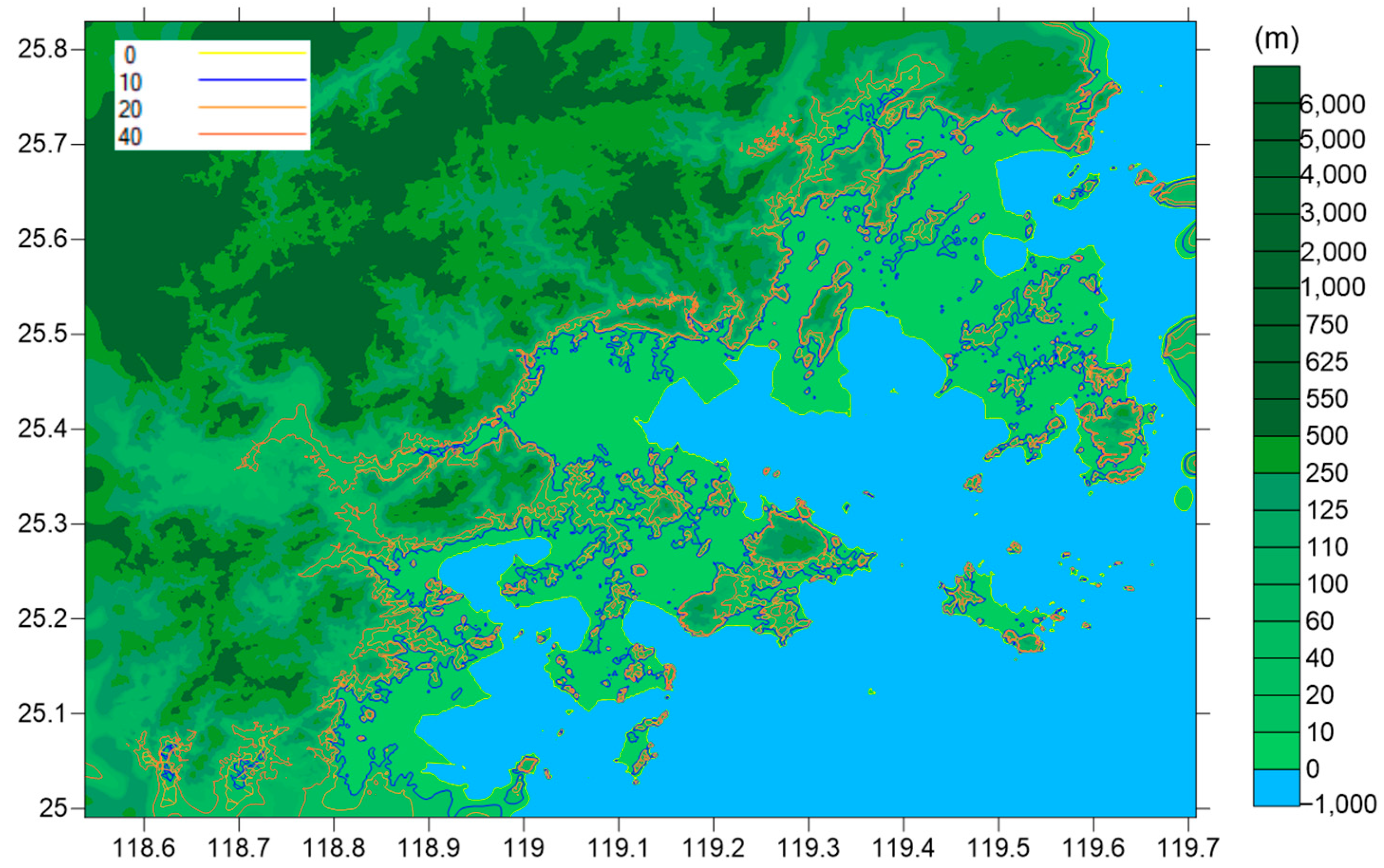
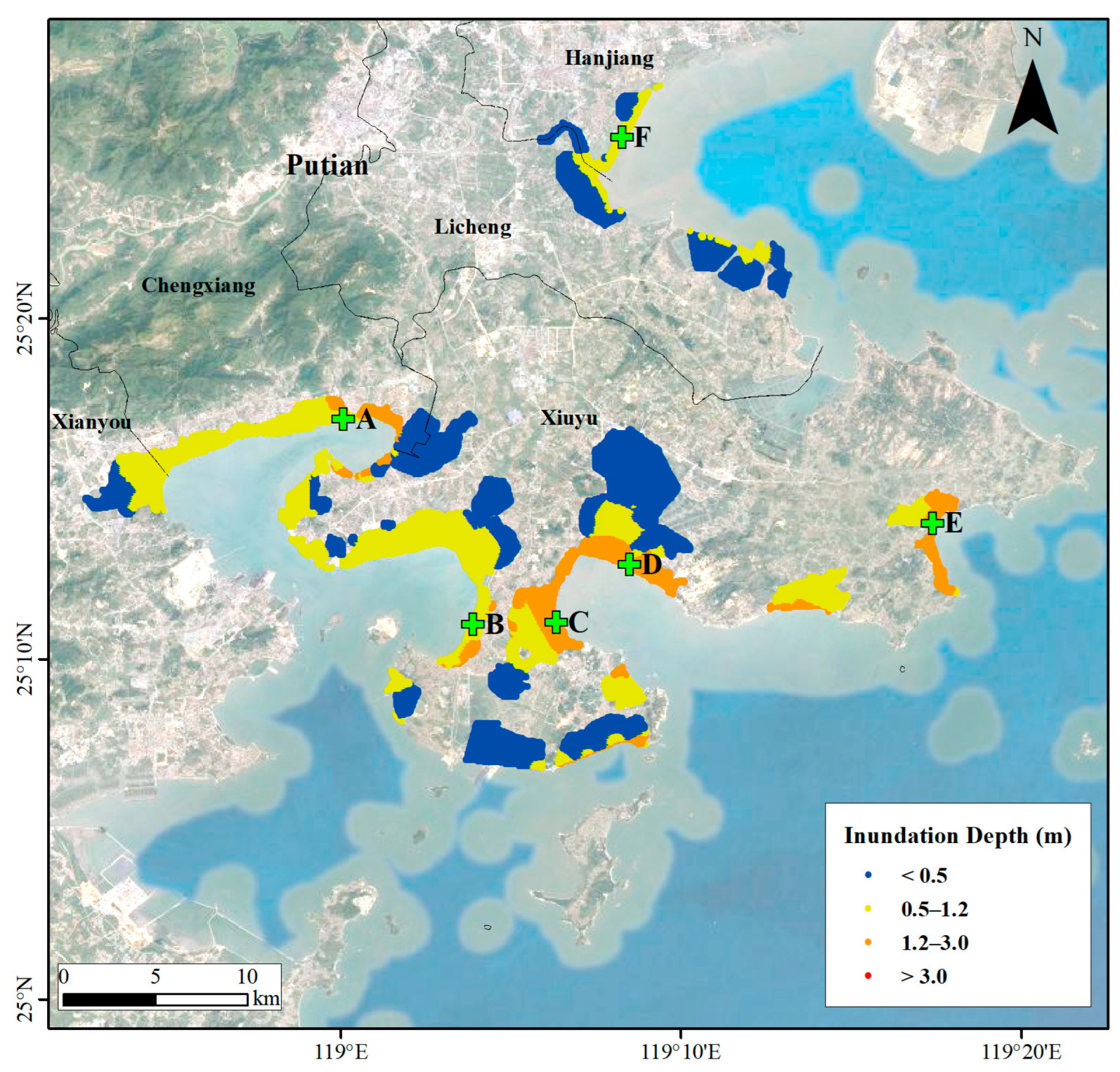
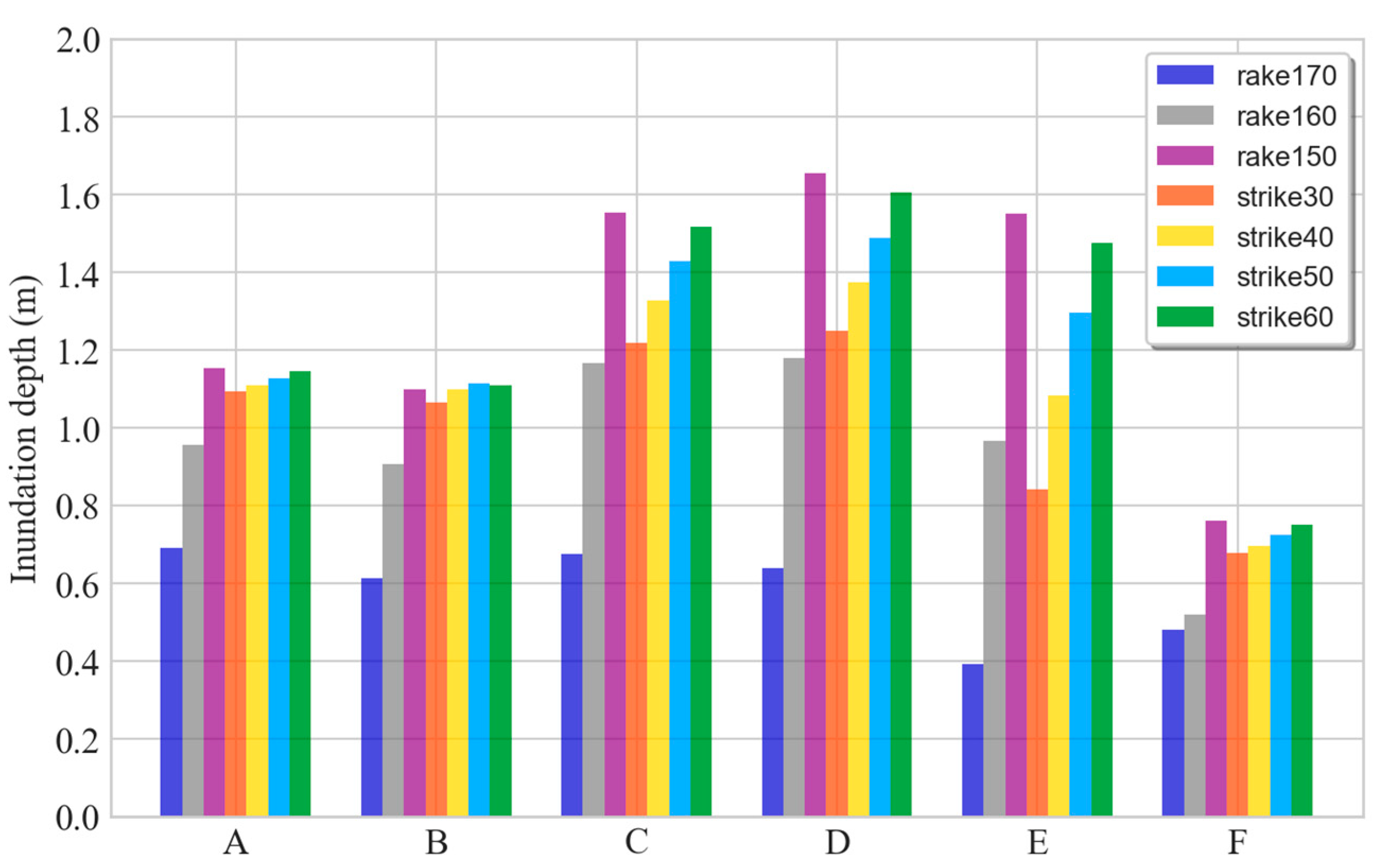
| Fault Parameters | |
|---|---|
| Longitude (°) | 119.42 |
| Latitude (°) | 24.74 |
| Mw | 8.0 |
| Length (km) | 92 |
| Width (km) | 71 |
| Depth (km) | 20 |
| Strike (°) | 65 |
| Dip (°) | 60 |
| Rake (°) | 150 |
| Level 1 | Level 2 | Level 3 | |
|---|---|---|---|
| Range of latitude (°) | −5.0 to 52.0 | 21.5–26.5 | 24.99–25.83 |
| Range of longitude (°) | 99.0–157.0 | 117.0–122.5 | 118.54–119.71 |
| Data resolution | 2′ | 1/4′ | 1/32′ |
| Coordinate system | Spherical | Spherical | Spherical |
| Manning’s n | / | 0.025 | 0.025 |
| Governing equation | Linear | Nonlinear | Nonlinear |
| Scenario | Long. (°) | Lat. (°) | Mw | Depth (km) | Length (km) | Width (km) | Strike (°) | Dip (°) | Rake (°) |
|---|---|---|---|---|---|---|---|---|---|
| Rake170 | 119.42 | 24.740 | 8.0 | 20 | 92 | 71 | 65 | 60 | 170 |
| Rake160 | 119.42 | 24.740 | 8.0 | 20 | 92 | 71 | 65 | 60 | 160 |
| Rake1501 | 119.42 | 24.740 | 8.0 | 20 | 92 | 71 | 65 | 60 | 150 |
| Strike30 | 119.42 | 24.740 | 8.0 | 20 | 92 | 71 | 30 | 60 | 150 |
| Strike40 | 119.42 | 24.740 | 8.0 | 20 | 92 | 71 | 40 | 60 | 150 |
| Strike50 | 119.42 | 24.740 | 8.0 | 20 | 92 | 71 | 50 | 60 | 150 |
| Strike60 | 119.42 | 24.740 | 8.0 | 20 | 92 | 71 | 60 | 60 | 150 |
Disclaimer/Publisher’s Note: The statements, opinions and data contained in all publications are solely those of the individual author(s) and contributor(s) and not of MDPI and/or the editor(s). MDPI and/or the editor(s) disclaim responsibility for any injury to people or property resulting from any ideas, methods, instructions or products referred to in the content. |
© 2022 by the authors. Licensee MDPI, Basel, Switzerland. This article is an open access article distributed under the terms and conditions of the Creative Commons Attribution (CC BY) license (https://creativecommons.org/licenses/by/4.0/).
Share and Cite
Fan, T.; Hou, J.; Xu, Z.; Wang, Y.; Zhao, L.; Gao, Y.; Wang, P. Investigation of Local Tsunami Effect on Coastal Areas: A Case Study of Putian City, Fujian Province, China. Sustainability 2023, 15, 415. https://doi.org/10.3390/su15010415
Fan T, Hou J, Xu Z, Wang Y, Zhao L, Gao Y, Wang P. Investigation of Local Tsunami Effect on Coastal Areas: A Case Study of Putian City, Fujian Province, China. Sustainability. 2023; 15(1):415. https://doi.org/10.3390/su15010415
Chicago/Turabian StyleFan, Tingting, Jingming Hou, Zhiguo Xu, Yuchen Wang, Lianda Zhao, Yi Gao, and Peitao Wang. 2023. "Investigation of Local Tsunami Effect on Coastal Areas: A Case Study of Putian City, Fujian Province, China" Sustainability 15, no. 1: 415. https://doi.org/10.3390/su15010415
APA StyleFan, T., Hou, J., Xu, Z., Wang, Y., Zhao, L., Gao, Y., & Wang, P. (2023). Investigation of Local Tsunami Effect on Coastal Areas: A Case Study of Putian City, Fujian Province, China. Sustainability, 15(1), 415. https://doi.org/10.3390/su15010415







